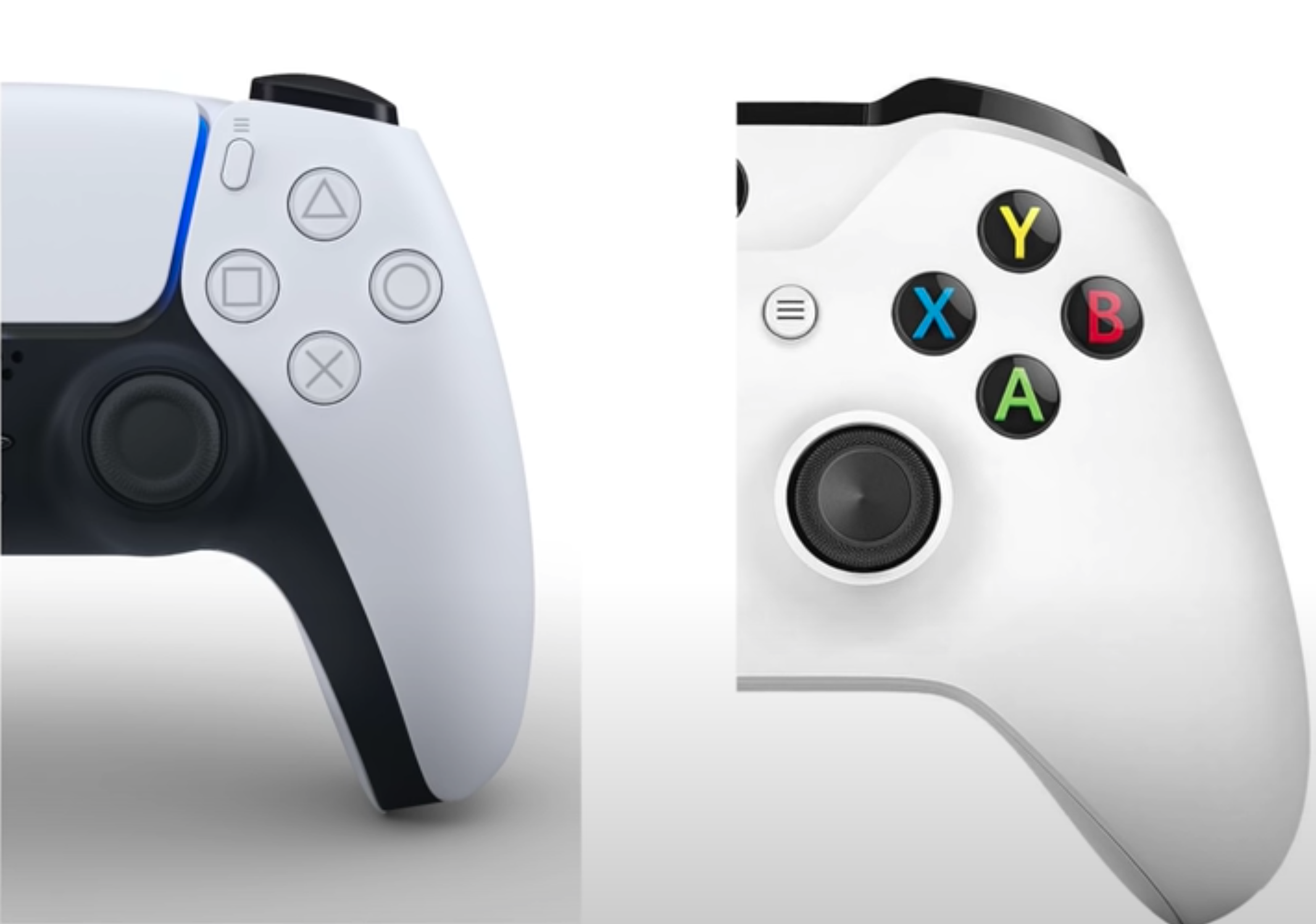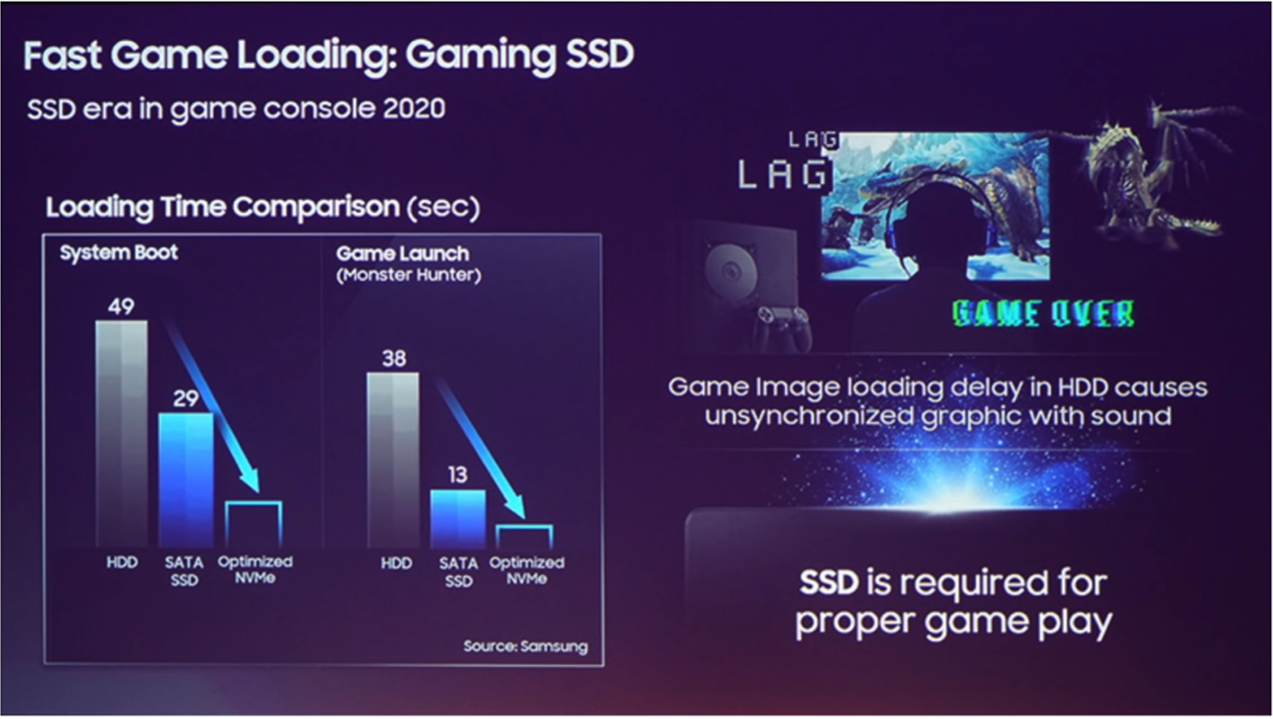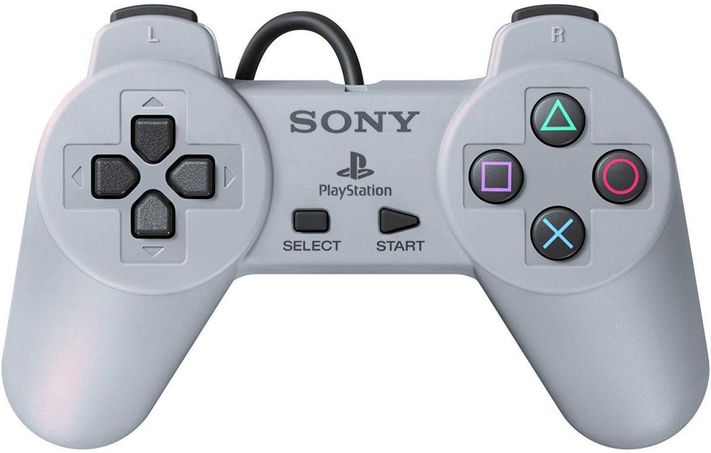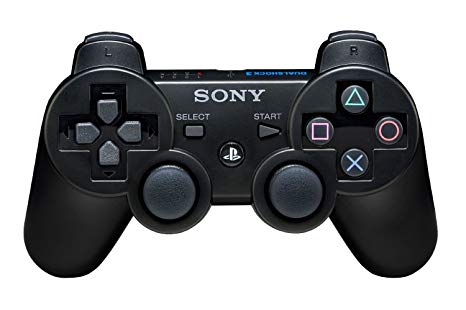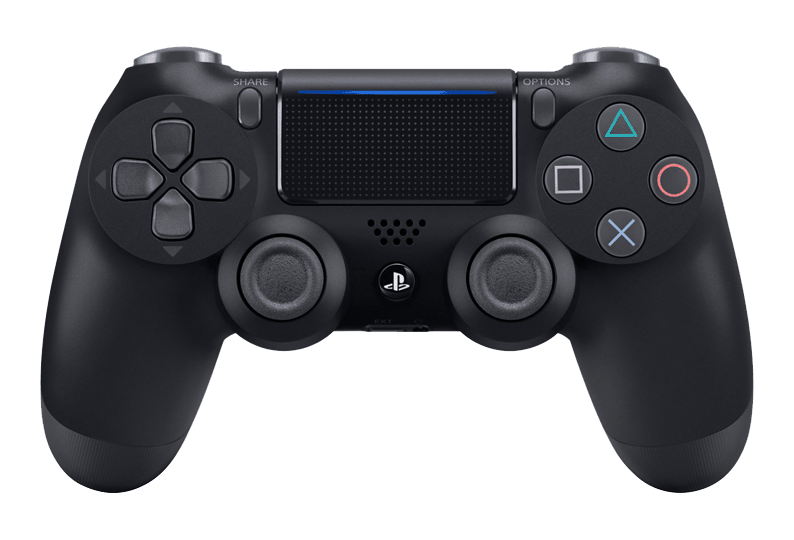Sony has introduced their brand new PlayStation 5 Controller. However, it’s not actually called the DualShock 5, like we all expected, but instead it is called… the DualSense.
We got hundreds of requests to make a video covering it. So, here are not just my thoughts on the PS5 controller, but also how it compares against all the previous Controllers that Sony has ever released. Without any further ado, here is the history of the PlayStation Controller.
PlayStation 1 Controller
Originally released back in 1994, the Playstation 1 Controller was the very first Gamepad that Sony ever released and they bundled this with the original PlayStation.
Something about this just doesn’t look right.
It was based on the Nintendo Super NES Controller’s design, featuring four Directional Buttons as well as four Action Buttons, but instead of Sony using letters for their Action Buttons, they decided to use shapes. The ‘X’ would represent a ‘Yes’, the ‘O’ would represent a ‘No’, The ‘Square’ would represent a sheet of paper and was originally designed for being the Info Button in games, and the ‘Triangle’ represented the Point of View (or Dialogue) Button. However, unlike Nintendo’s Super NES Controller, Sony decided to add a second pair of Shoulder Buttons (L1, L2, R1 & R2). Fun fact, the US variant of the PS1 Controller was 10% larger to account for the larger hands that the average American has, compared to the average Japanese person.
Dual Analog Controller
The Dual Analog Controller took the shape that were are all now very familiar with.
Now, you might have noticed that something was missing from the original PS1 Controller, those were the Joysticks. Well, they were actually only added in 1997, three years later, when Sony introduced the new Dual Analog Controller. This was, for a most part, just a PS1 Controller with Dual Joysticks added to it for “more refined controls in games”, according to Sony. The Shoulder Buttons were now larger, especially the R2 & L2 Buttons. More importantly, Sony also added an Analog Button, which was used to switch between different modes.
There were three modes that this Controller had. There was Digital Mode, which disabled the Joysticks, Analog Mode, which enabled the Joysticks, and then finally we had the Analog Joystick Mode, which emulated Sony’s separate Analog ‘Flight-Stick’ accessory. The Dual Analog Controller was indeed a pretty big upgrade and really the first ever upgrade we got in a Sony Controller.
DualShock
The DualShock 1 added those famous Vibration Motors.
In November of the same year, Sony released another Controller, which they called DualShock. The main change from the Dual Analog controller was the fact that Sony added Vibration Feedback in order to immerse you more into the game.
Now, each game had to support Vibration Feedback, things such as punching a character, or doing an action in a game like opening a door, would trigger this vibration. Nintendo already had this with the N64’s Rumble Pack, but Sony decided to step it up a notch by adding a Vibration Motor in each of the Hand-Grips, rather than just having one main Vibration Motor.
Not only that, but these two Motors didn’t require a separate Battery to work, like Nintendo’s Rumble Pack did. Instead, they just worked inside the Controller and they were powered by the Controllers cable. So, that was pretty big, games started implementing Vibration Support heavily and we all know how important this is today. The other change that the DualShock brought to the table was even bigger Shoulder Buttons, compared to the Dual Analog.
DualShock 2
Next up, we have the DualShock 2. Originally introduced in 2000, the DualShock 2 was launched alongside the PlayStation 2.
Pressure Sensitive Buttons opened the door for developers to experiment with games even further.
The main change was that the entire Controller was now black, as opposed to the grey look that we’ve had since the original PS1 Controller. Aside from this, some users reported that the Vibration Motor felt stronger in the DualShock 2, although this was never confirmed. But what we did indeed get, were Pressure Sensitive Buttons.
Essentially, aside from the Joysticks and the Start, Select, Analog, L3 and R3, the rest of the buttons were all pressure sensitive. Meaning that rather than just registering a value of ‘1’ when pressed, it would register anything between ‘0’ and ‘1’ from the moment you rested your finger on it. This was extremely useful in Racing games, where you could accelerate just a tiny bit by only lightly pressing the Shoulder Button.
Sixaxis Controller
In 2006, with the introduction of the PlayStation 3, Sony launched the DualShock 3. Actually, just kidding, it was the Sixaxis Controller that came first.
This was the first PlayStation Controller that was completely wireless.
Design wise, it looked almost identical to the PS2 Controller, which was released six years prior. But, the biggest change here was that it was completely wireless. You still had a cable that you would use for charging and you could keep it connected if you wanted to do so, but the Controller itself could now be used without a cable at all. It would work just as well as before.
On top of this, Sony added 6-axis Motion-Sensing Technology, hence the name of their Sixaxis Controller. This meant that the Controller could feel Rotation and Translation across the X, Y & Z axis, allowing you to, for example, control a Car by just using the Controller as steering wheel, or control a Plane by using the controller like a Yoke. It was pretty cool!
Unfortunately, the Sixaxis functionality didn’t end up being used as much as Sony had hoped. Even to this day, 14 years later, there are very few games that do make full use of it. Also, fun-fact, Sixaxis was a palindrome, meaning that if you reverse the word, it would still spell Sixaxis. Also, Sony removed the famous Vibration Motors entirely from the Sixaxis Controller, due to a patent dispute that Sony was having.
Aside from this, the Analog button was replaced by a ‘PlayStation’ Button, which would just take you Home. The Sixaxis also included finer Shoulder Button precision, compared to the DualShock 2 Controller.
DualShock 3
Just some of the many different iterations of the DualShock 3.
Less than a year after the new Sixaxis Controller was launched, Sony had managed to settle the patent battle against Immersion (who sued them) and because of this, they could use Vibration Feedback once more.
So, Sony released the DualShock 3, which was really just a Sixaxis Controller with the added Vibration Feedback. Aside from that, it was pretty much identical to the Sixaxis. Sony did end up releasing new colours for the DualShock 3 Controller, including White, which looked absolutely stunning. This the very first time that Sony would release multiple colour variants of their Controllers.
DualShock 4
Then, in 2013, when Sony launched the PS4, they also launched the DualShock 4. Unlike all of the previous Controllers, which all looked pretty much identical, the DualShock 4 was actually the first major change for a PlayStation Controller.
The Handles were now more rounded, longer and overall, the entire Controller was much more comfortable to hold, compared to any of the previous ones. The Joysticks were now Concave, as opposed to Convex, like the previous ones were. Personally, I did find them way more comfortable compared to the DualShock 3 Controller for example.
But, as well as this, the DualShock 4 also had some other gigantic changes. It removed the Start & Select Buttons and added a massive Touchpad instead, which could recognise multiple fingers at the same time. This was a capacitive, rather than a resistive, touch surface. It was pressable as well, so it acted as an extra Button.
Unfortunately, just like the Sixaxis Motion-Sensing technology, the Touchpad didn’t really get used by games at all, aside from some exclusive games such as ‘Little Big Planet’ and ‘Astrobot VR’. Most games use it as a Button for the Map or the Highscore, acting in the same way as the Tab Key on PCs.
Compared to previous generations, this was a huge design leap.
The other big change was that the back of the Controller had a big LED Strip. The main purpose of this was that the PlayStation 4 Camera could track its movement, you could use it in games this way. Following the PlayStationVR’s release, the light was also used by the PlayStation 4’s Camera to track the moment of the Controller, in VR. Aside from this, the light would also change its colour based on certain events in a game. For example, if your Health would run low, the light would turn red, but if you were at Full Health, the light would be green.
The PS4 controller, also added a Speaker for sound effects. It also added a proprietary Connector for connecting things such as a Keyboard Attachment or the new Back Button Attachment. It also added a 3.5mm Headphone Jack, which allowed you to connect any set of Headphones to it, you would hear the audio from the games directly from your Controller with no noticeable lag at all. That was incredible and definitely my favourite feature ever, in any Controller. We also got a new Options Button for bringing up the Options Menu in games, as well as a new Share Button for taking screenshots and video recordings of your Gameplay. We also got a microUSB Port, a change from the miniUSB Port that we had on the DualShock 3 Controller.
Sony also expanded on the success that the coloured versions of the DualShock 3 received by releasing even more colour options for the PS4 Controller. We also saw limited editions of the PS4 that also came bundled with a limited edition Controller. All of these improvements made the PS4 Controller a massive technological leap, compared to its predecessors.
DualShock 4 Pro
The latest version that we can currently get our hands on. This was a small tweak to the existing design.
When Sony launched the PS4 Pro in 2016, they also released an updated version of the DualShock 4. It was still called the DualShock 4, but this was the PS4 Pro version of it. This now reflected the Light-Bar onto the Touchpad as well, so that you could also see it more easily. It also included the ability to use it via a wired USB connection, with even lower Latency than when connected wirelessly, and it also featured an improved Battery Life.
DualSense
Finally, the latest Controller that Sony has unveiled, is the Playstation 5 Controller. Interestingly enough, rather than this being called the DualShock 5, it is called the DualSense.
Design wise, just like the DualShock 4, the DualSense embraces a completely fresh design style. This time, coming in a dual-tone colour scheme. The one that Sony has showed us came in White, with Black Accents, but we do expect Sony to launch even more colour options. There will very likely be a Black Controller with White Accents as well as a few more colour variants as well.
Aside from the colour scheme, the shape of the Controller is now very different as well. It resembles the Xbox One Controller much more than ever before. It is bigger, heavier and according to Sony, it feels more premium than ever before. We still have the same Buttons as before, but all those Buttons have a glass enclosure, which again is similar to how they look on the Xbox. So, gone are the coloured Action Buttons that we’ve seen for so many years now.
The ‘Options’ and ‘Share’ Buttons are still there. The ‘Share’ has been renamed into the ‘Create’ Button but it still acts the same way. They have also been rotated slightly to make room for the larger Touchpad. Which still has the built-in LED light, but it now surrounds the Touchpad rather than being underneath it.
Something about the DualSense looks a little familiar.
In case you’re wondering about that back LED light, that now seems to be gone entirely, which means that the PSVR 2 will very likely use a very different tracking technology. We’ve seen multiple patents on this before, where Sony would be using a laser-based tracking system for the PSVR 2. But anyway, that’s not said to be released until at least 2021.
Another change that the DualSense comes with is USB C Port, a change from the microUSB Connector, meaning that now you can use a Smartphone charger, a Laptop charger or pretty much anything, to charge the PS5 Controller. Battery Life has been improved significantly, according to Sony. They’ve also added on-board Microphones, meaning that you can now chat without having a Microphone plugged in. Of course, the 3.5mm Headphone Jack is still there, in case you do want to add some Headphones.
Now, let’s talk about the big changes here, the ones that will affect your Gameplay. The first ones are the brand new ‘Adaptive Pressure Sensitive’ L2 & R2 Triggers. Just like pulling a Bow-String or an actual Gun Trigger, they will be harder to push, the further you push down. This does sound very similar to what Microsoft added in their Xbox One Controller.
The biggest change, and the reason why this is called DualSense, is that it features a full Haptic Engine all throughout the Controller. Ok, but what is this exactly? You know how on modern Smartphones, such as the iPhone 11, the Pixel 4, the Samsung Galaxy S20’s, the OnePlus 8 and many others, we have an improved Vibration Motor that gives you a tactile response, whenever you press a Menu or Action Button? It essentially gives you the impression that you pressed a physical Button. Well, the PS5’s Haptic Feedback would be similar, just on Steroids. According to Sony, the Haptic Feedback is so good that you’ll be able to feel the textures on different roads. You’ll be able to feel mud, asphalt, ice and more, or even feel how different Guns shoot. From what I’ve heard, this is an absolute game changer.
So, there you go. This is how far we’ve come from the original PS1 Controller and I’m personally really looking forward to trying the PS5 Controller out!









